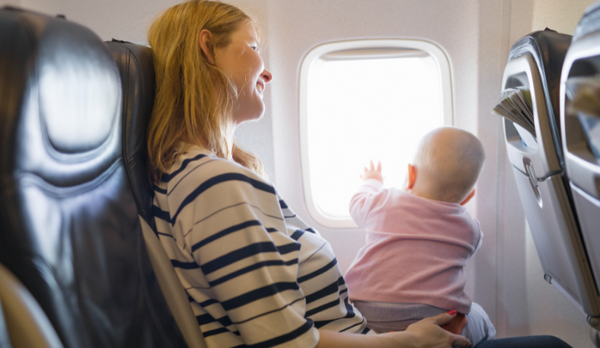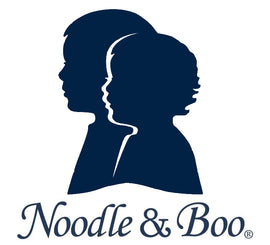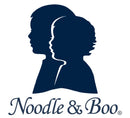
Traveling with a baby can be daunting, and rightfully so! Air travel can get hectic, and your baby could be unpredictable if they’ve never been on a plane. Preparing for any or all scenarios will alleviate the stress of flying for you and your baby. If you’re flying with a newborn, your airline may have age restrictions so always double check before booking.
Before you fly, remember that if you are traveling internationally with your baby, a passport is mandatory for them. While there is no official age requirement for your baby to fly, try to avoid flying unnecessarily – air travel could increase a newborn’s risk for getting sick.
Booking your Flight
When booking a flight, try to choose a bulkhead (front row) seat and request a bassinet if it’s possible. Both you and your newborn will be able to rest comfortably, and you’ll have a little bit more room. If your baby is a little bit older, the bulkhead may not be a good option since you won’t have space to store supplies or toys. If you can’t get a front row seat, try to sit as close to the front as possible! The front of the plane is slightly quieter, as it’s away from the engine.
Arriving at the Airport
Coming to the airport about 90 minutes to 2 hours early will alleviate your worries. Give yourself plenty of time, now that you have a newborn and baby gear to carry with you! Coming early means no matter how fast or slow the lines are, you’ll be able to get to your terminal before the flight. Arriving early is great; you can rest after waiting in line and do any necessary diaper changes for your baby.
If you plan on checking in your stroller, baby wearing is a great idea! Not only is physical contact comforting for your baby, you’ll also have your hands free to hold your luggage.
How much baby formula or breast milk can I take on a plane?
According to the TSA, formula and breast milk are exempt from the 3-1-1 liquids rule. So, you can bring as much as you feel is necessary for your flight and your vacation.
Boarding the Plane
It can be so overwhelming boarding the plane with your baby, personal bag, and your carry-on. Not to mention, there’s also a risk that you and/or your baby could be injured by someone who’s trying to lift up their carry-on into the overhead bin.
To reduce the chances of stress and injury, have the person you’re flying with (whether that’s your spouse, family, or friend) board first with your carry-on or bag. You and baby can board later, which means your baby spends less time aboard.

Could my baby sit on my lap during the flight?
While little ones under 2 can travel free (or at a discounted rate for international flights), having him or her on your lap is not recommended. It can be unsafe, but also can get uncomfortable for the both you depending on the duration of the flight.
Not every car seat can be used on a plane. To check if yours is safe for the flight, look for the label that says “This restraint is certified for use in motor vehicles and aircraft”.
The safest way for your little one to fly is in an approved car seat. Generally, car seats and strollers aren’t considered luggage, but policies can vary, so check with your airline before flying. If your baby is less than 20 lbs, he or she should use a rear-facing CRS, and if your little one weights 20-40lbs, they should be in a forward-facing car seat. Once you’re on the plane, ask a flight attendant to help you strap in the car seat if you have issues.
Your baby should sit away from the aisle as a precaution to drink carts, overhead items, or passengers that may be walking around the plane.

How can I keep my baby comfortable and content during air travel?
Be ready for ear pain. Pressure changes during takeoff and descent can cause discomfort for your little one. Drinking from a bottle or breast, or even sucking on a pacifier can help. Pack extra pacifiers in case one drops! Plan to feed your baby during takeoff or landing, since that’s when the most ear pressure will occur.
Dress in layers. The temperature could fluctuate while you’re in the plane, and having layers will keep your baby content and not too stuffy. Wearing layers will help make diaper changes smoother. Also consider bringing an extra change of clothes in case of an accident, and bring a plastic bag to hold any soiled clothes or dropped pacifiers.
Speaking of diaper changes, consider putting a fresh diaper on your baby before boarding. While many planes have changing tables in the restroom, a dry diaper will save you the headache of doing a diaper change on the flight. Wet wipes will be your new best friend when you’re on board. Wipe down foldable tables, windows, or anything your baby might touch.
Bring entertainment. Pack a few of your baby’s favorite toys along with some new ones to keep them entertained.
Despite all your planning and prepping, your baby may cry, and that’s okay. That’s just the nature of things! Know that you’re doing all that you can to make the flight as comfortable as possible for your baby and yourself. You aren’t the first person to fly with an infant, so don’t hesitate to ask for help if you’re flying alone. A flight attendant will be able to accommodate your requests.
Safe travels, mama!










Leave a comment